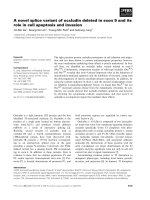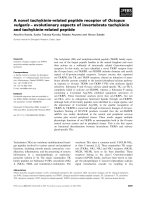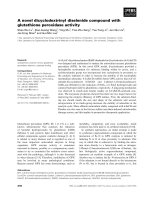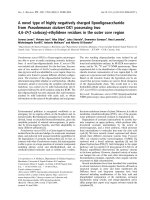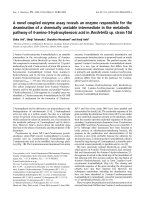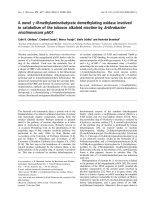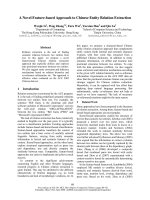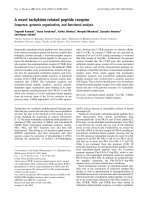Báo cáo khoa học: A novel serine protease highly expressed in the pancreas is expressed in various kinds of cancer cells potx
Bạn đang xem bản rút gọn của tài liệu. Xem và tải ngay bản đầy đủ của tài liệu tại đây (738.38 KB, 13 trang )
A novel serine protease highly expressed in the pancreas
is expressed in various kinds of cancer cells
Shinichi Mitsui
1,
*, Akira Okui
2
, Katsuya Kominami
2
, Eiichi Konishi
1
, Hidetoshi Uemura
2
and Nozomi Yamaguchi
1
1 Department of Cell Biology, Research Institute for Geriatrics, Kyoto Prefectural University of Medicine, Kyoto, Japan
2 Research and Development Center, Fuso Pharmaceutical Industries Ltd, Morinomiya, Joto-ku, Osaka, Japan
Serine proteases play important roles in a variety of
physiological processes, such as blood coagulation,
growth factor processing, the digestion of nutrients,
and cell migration, when cells move to the target
organs and reconstitute extracellular matrices, especi-
ally during developmental stages. In the central ner-
vous system (CNS), serine proteases are believed to be
involved in various neuronal functions [1]. Tissue-type
plasminogen activator is essential for memory forma-
tion and seizures [2,3]. Knockout mice lacking neuro-
psin ⁄ KLK8, a member of the kallikrein family, have a
reduced number of active synapses [4]. On human and
mouse genomes, over 500 proteases are encoded [5]
and some proteases other than plasminogen activator
and neuropsin may contribute to neuronal function.
We have recently reported a novel transmembrane
Keywords
cerebellum; chromosome 16; ovarian
cancer; tumor marker
Correspondence
N. Yamaguchi, Department of Cell Biology,
Research Institute for Geriatrics, Kyoto
Prefectural University of Medicine,
Kyoto 602-8566, Japan
Fax: +81 75 251 5848
Tel: +81 75 251 5797
E-mail:
*Present address
Department of Neurobiology and Anatomy,
Kochi Medical School, Okou, Nankoku 783-
8505, Japan
Database
The nucleotide sequence reported in this
paper has been entered in the DDBJ ⁄ Gen-
Bank ⁄ EMBL databases under accession no.
AB010779
(Received 25 November 2004, revised 4
July 2005, accepted 3 August 2005)
doi:10.1111/j.1742-4658.2005.04901.x
We have isolated a cDNA that encodes a novel serine protease, prosemin,
from human brain. The cDNA of human prosemin is 1306 bp, encoding
317 amino acids. It showed significant homology with the sequence of a
chromosome 16 cosmid clone (accession no. NT_037887.4). The prosemin
gene contains six exons and five introns. The amino acid sequence of prose-
min shows significant homology to prostasin, c-tryptase, and testisin (43%,
41%, and 38% identity, respectively), the genes of which are also located
on chromosome 16. Northern hybridization showed that prosemin is
expressed predominantly in the pancreas and weakly in the prostate and
cerebellum. However, western blot and RT-PCR analyses showed that
prosemin is expressed and secreted from various kinds of cancer cells, such
as glioma, pancreas, prostate, and ovarian cell lines. Prosemin is secreted
in the cystic fluid of clinical ovarian cancers. Furthermore, immunohisto-
chemistry showed prosemin protein localized in the apical parts of ovarian
carcinomas. Recombinant prosemin was expressed in COS cells and was
purified by immunoaffinity chromatography. Recombinant prosemin pre-
ferentially cleaved benzyloxycarbonyl (Z)-His-Glu-Lys-methylcoumaryl
amidide (MCA) and t-butyloxycarbonyl (Boc)-Gln-Ala-Arg-MCA. Our
results suggest that prosemin is a novel serine protease of the chromo-
some 16 cluster that is highly expressed in the pancreas. The usefulness
of this serine protease as a candidate tumor marker should be further
examined.
Abbreviations
Boc, t-butyloxycarbonyl; Bz, benzoyl; CNS, central nervous system; Glu(Obzl), glutamic acid c-benzyl ester; Glp,
L-pyroglutamyl; MCA,
4-methylcoumaryl-7-amidide; NHS, N-hydroxysuccinimide; Z, benzyloxycarbonyl.
FEBS Journal 272 (2005) 4911–4923 ª 2005 FEBS 4911
serine protease, spinesin ⁄ TMPRSS5, which is localized
at synapses [6]. Motopsin (PRSS12) is a mosaic serine
protease, with a kringle domain and three scavenger
receptor cysteine-rich domains, that is expressed pref-
erentially in motor neurons [7,8]. Some novel members
of the kallikrein family have also been reported. Hip-
postasin (KLK11) is expressed in hippocampal pyram-
idal neurons and shows kallikrein-like enzyme activity
[9]. Another kallikrein-like protease, neurosin (KLK6),
which has trypsin-like activity, is secreted by activated
microglial cells and localized on senile plaques and
Lewy’s bodies [10,11]. We have shown that the alter-
native splicing of neuropsin ⁄ KLK8 is regulated in a
tissue-specific manner [12]. These proteases are thought
to play important roles in neuronal functions via the
digestion of extracellular matrices, the processing of
growth factors, and the activation of cell-surface recep-
tors. However, such proteolytic phenomena occur
markedly in tumor cells as well as in the CNS. Some
of the proteases described above have been reported to
be tumor markers, although they are expressed pre-
dominantly in the CNS. Neuropsin was identified as a
serine protease that is overexpressed in ovarian carci-
nomas, although its mRNA is detected negligibly in
normal ovaries [13,14]. Serum neurosin levels are ele-
vated specifically in patients with ovarian cancer [15].
Furthermore, we have previously reported that the
alternative splicing of hippostasin is regulated in a
cancer-specific manner [16]. In addition, serum levels
of hippostasin are increased in patients with ovarian
and prostate cancers [17]. Other kallikreins are aber-
rantly expressed in many types of cancers and their
expression is often associated with patient prognosis
(reviewed in [18–20]).
Here, we describe a novel member of the chromo-
some 16 serine protease family. Prosemin cDNA was
isolated from a human brain cDNA pool. Immuno-
chemical and RT-PCR analyses revealed that prosemin
is expressed in various kinds of cancer cell lines and in
clinical samples of ovarian carcinomas. The characteri-
zation and functions of prosemin are described.
Results
cDNA cloning and structure of the prosemin
gene
We isolated a cDNA of 958 bp that encodes a novel
serine protease of 317 amino acids from human brain
cDNA pool. The predicted amino acid sequence
includes a serine protease motif, and this protein was
designated ‘prosemin’, as this protein was first detected
in seminal fluid (data not shown). A BLAST search
of the human genome draft sequence showed
that this gene is located on chromosome 16p13.3
(NT_037887.4). Although human prosemin cDNA was
isolated from the brain, northern hybridization showed
that prosemin is expressed strongly in the pancreas, but
weakly in the prostate and cerebellum (Fig. 4). The
nucleotide sequences of the cDNA and the cosmid
clone are identical. A comparison of the cDNA and ge-
nomic sequences clarified the gene structure of human
prosemin (Fig. 1). The prosemin gene is approximately
6.5 kb, and contains six exons and five introns. All
exon–intron boundaries are consistent with the GT–
AG rule. The exons range in size from 27 to 601 bp.
The second exon encodes only nine amino acids, which
constitute part of the pro-enzyme fragment. The initi-
ation codon is consistent with Kozak’s consensus
sequence [21]. Although we did not determine the tran-
scription initiation site, the 5 ¢ UTR appears to be lon-
ger than 67 bp because the primer for the first PCR
used to isolate the full-length cDNA was designed to
hybridize with that position (at 991 in Fig. 2). Further,
homology search showed that our sequence contained
the longest 5¢ UTR when compared with EST
sequences. Several transcription regulatory elements
occur within 1.2 kb upstream from the first exon: three
AP-1 sites, a CREB binding site, and a NF-jB binding
site. There is no typical TATA or CAAT box in the
putative promoter region. The putative signal sequence
is encoded by the first exon, and the pro-enzyme frag-
ment is encoded by exons 1 and 2. The catalytic triad,
His, Asp, and Ser, is encoded in exons 3, 4, and 6,
respectively. Exon 6 contains a polyadenylation signal.
Structure of human prosemin
The predicted amino acid sequence of prosemin shows
that this protein belongs to the chymotrypsin (S1) fam-
ily and may be synthesized as a prepro form. Hydro-
pathy plot analysis showed that the 32 amino acids of
the N-terminus constitute a putative signal sequence
(data not shown). A typical serine protease activation
motif is also conserved at Arg49-Val-Val-Gly-Gly, sug-
gesting that the 17 amino acids from Ala33 to Arg49
might comprise the pro-fragment of prosemin. A pos-
sible N-glycosylation site occurs at Asn70 in the cata-
lytic domain. The essential triad for protease activity
was identified at His90, Asp141, and Ser242. An aspar-
tate residue six amino acids before the active Ser242
suggests that prosemin has trypsin-like activity. In
addition to a similarity in gene structure, a homology
search of the SWISSPROT protein database showed
significant similarity between prosemin and prostasin,
c-tryptase, and testisin, with 43%, 41%, and 37.5%
A novel serine protease in various cancer cells S. Mitsui et al.
4912 FEBS Journal 272 (2005) 4911–4923 ª 2005 FEBS
Fig. 1. Gene structure and amino acid sequence of human prosemin. Exons and putative cis-acting elements in the promoter region are boxed. The exon–intron boundary consensus
sequences and the polyadenylation signal are indicated by double and single underlines, respectively. The consensus amino acids for serine proteases are shown in white letters. An arrow
and circle indicate the putative processing site and the N-glycosylation site, respectively. The genomic sequence is derived from cosmid clone 325D7 taken from GenBank.
S. Mitsui et al. A novel serine protease in various cancer cells
FEBS Journal 272 (2005) 4911–4923 ª 2005 FEBS 4913
identity, respectively (Fig. 2). Amino acid alignment of
these proteases shows that 10 of the 12 cysteine resi-
dues in the prosemin zymogen are conserved among
these proteases. Cys41 is predicted to form a disulfide
bond with Cys175, as in other S1 proteases, whereas
the a-, b-, and d-tryptases do not contain a cysteine
residue in the pro-enzyme fragment. However, pro-
semin does not contain a hydrophobic region at the
carboxyl terminus. This portion is apparently different
from the corresponding regions of prostasin, c-tryptase
and testisin, which anchor the proteins to the plasma
membrane.
Fig. 2. Amino acid alignment of the chromosome 16 serine protease family. White letters indicate amino acids identical to those in human
prosemin. Asterisks show the amino acids conserved among the seven proteases. Dashes denote gaps. The essential triad and peripheral
sequences are indicated by lines. Cys41 in the pro-enzyme fragment may form a disulfide bond with Cys175 in the catalytic domain.
A novel serine protease in various cancer cells S. Mitsui et al.
4914 FEBS Journal 272 (2005) 4911–4923 ª 2005 FEBS
Enzyme activity of human prosemin
To analyze the enzyme activity of prosemin, recombin-
ant prosemin was expressed in COS cells. In our system,
the putative catalytic domain was fused with the prepro-
enzyme fragment of human trypsinogen. Recombinant
prosemin was secreted into the conditioned medium
and purified by immunoaffinity chromatography. SDS ⁄
PAGE of purified prosemin produced a single band of
33 000 Da, which reacted with anti-prosemin IgG
(Fig. 3A). Purified prosemin still contained the pro-
enzyme fragment of trypsinogen and was activated by
enterokinase (Fig. 3B–D). Activated prosemin cleaved a
fluorescent substrate [t-butyloxycarbonyl (Boc)-Gln-
Ala-Arg-4-methylcoumaryl-7-amidide (MCA)], whereas
preactivated recombinant prosemin and enterokinase
showed no activity against the same substrate.
SDS ⁄ PAGE showed that enterokinase treatment of
recombinant prosemin caused a decrease in the mole-
cular mass from 33 000 to 31 000, indicating successful
digestion of the artificial trypsinogen pro-enzyme frag-
ment. The amount of 31 kDa prosemin increased in pro-
portion to the time of incubation with enterokinase.
Prosemin activity appeared to be related to the amount
of 31 kDa protein, although extended incubation
caused some degradation of the recombinant prosemin,
A
BC
FED
Fig. 3. Enzymatic characterization of recombinant prosemin. (A) SDS ⁄ PAGE of purified recombinant prosemin. Anti-prosemin IgG raised
against a synthetic peptide recognized this protein (lane 1). Purified prosemin was detected as a single band by silver staining (lane 2).
(B) After activation by enterokinase, recombinant prosemin was incubated with Boc-Gln-Ala-Arg-MCA at 37 °C for the indicated times. White
and shadowed bars indicate before and after activation by enterokinase, respectively. Black bars indicate the enzymatic activity of entero-
kinase on the substrate. The closed circles and line indicate prosemin enzyme activity after activation of the protein by enterokinase; the
enzymatic action of enterokinase upon the substrate has been subtracted. Mean values and standard deviations (SD; n ¼ 3) are indicated.
(C) Activation of recombinant prosemin by enterokinase. Purified recombinant prosemin was incubated with enterokinase at 37 °C for 0
(lane1), 5 (lane 2), 24 (lane 3), 48 (lane 4) h. After incubation, the recombinant protein was visualized by silver staining after SDS ⁄ PAGE. (D)
The enzymatic activity of prosemin activated for various times was measured at 37 °C using the substrate Boc-Gln-Ala-Arg-MCA. (E) Recom-
binant prosemin activated for 24 h was incubated with the indicated substrates for 1 h at 37 °C. Mean values and SD are shown (n ¼ 3). (F)
Activated prosemin was incubated with Boc-Gln-Ala-Arg-MCA at 37 °C for 1 h at various pHs. Phosphate buffer (0.1
M) and Tris ⁄ HCl (0.1 M)
buffer were used for pH 5.0–9.0 and pH 9.0–11.0, respectively. Mean values and SD are shown (n ¼ 3).
S. Mitsui et al. A novel serine protease in various cancer cells
FEBS Journal 272 (2005) 4911–4923 ª 2005 FEBS 4915
including autodegradation. These results indicate that
the detected activity derived from the activated recom-
binant prosemin.
At pH 8.0, recombinant prosemin the most preferen-
tially cleaved benzyloxycarbonyl (Z)-His-Glu-Lys-
MCA, and it showed high enzymatic activity against
Boc-Gln-Ala-Arg-MCA and Boc-Glu(Obzl)-Ala-Arg-
MCA, which are substrates for trypsin and factor XIa,
respectively, and weakly cleaved Boc-Val-Pro-Arg-
MCA, Pro-Phe-Arg-MCA, l-Pyroglutamyl (Glp)-Arg-
MCA, and Boc-Phe-Ser-Arg-MCA (Fig. 3E). The
optimum pH for prosemin activity was investigated
using Boc-Glu-Ala-Arg-MCA as substrate (Fig. 3F).
Activated recombinant prosemin showed no enzymatic
activity at pH < 6.0. Prosemin showed maximum
enzymatic activity at pH 8.0–9.0, and showed about
half maximal activity at pH > 10.0.
Expression of prosemin mRNA in normal human
tissues
Prosemin mRNA of 1.4 kb was expressed strongly in
the pancreas and weakly in the prostate and cerebel-
lum (Fig. 4A). We isolated a cDNA fragment encoding
prosemin from a human brain cDNA pool. However,
prosemin mRNA was detected only in the cerebellum.
It was not detected in other regions of the brain, such
as the thalamus, substantia nigra, hippocampus, cor-
pus callosum, caudate nucleus, or amygdala (data not
shown). However, using RT-PCR, we detected prose-
min mRNA in most human tissues except the hippo-
campus and liver (Fig. 4B). The levels of prosemin
expression are very low in these tissues.
Prosemin expression in various cancer cell lines
Recently, some serine proteases, including testisin and
prostasin, have been reported as tumor markers. The
expression of prosemin in cancer cell lines was ana-
lyzed. Immunoblotting using anti-prosemin IgG detec-
ted a protein of 33 kDa, which is identical to the
molecular mass of recombinant prosemin, in condi-
tioned medium from some human cancer cell lines
(Fig. 5A). A 20 kDa protein was detected in some cell
lines, such as HPC-Y0, HPC-YS, SKOV-3, OVK-18,
DU-145, U373, KHG2, HOG, KP-N-YN, Colo38,
A
B
Fig. 4. Expression of prosemin in normal human tissues. (A) Northern hybridization was carried out overnight at 65 °C. Strong signal was
detected in the pancreas, and weak signals were observed in the prostate and cerebellum. (B) Expression of prosemin mRNA was analyzed
by RT-PCR. A specific band of the expected size was detected in most human tissues (arrowhead).
A novel serine protease in various cancer cells S. Mitsui et al.
4916 FEBS Journal 272 (2005) 4911–4923 ª 2005 FEBS
and OUR-10, although the 33 kDa protein was not
detected. Either the 33 kDa or the 20 kDa protein was
detected in all 11 pancreatic cancer cell lines and four
colon cancer cell lines. An immunoreactive 20 kDa
protein was detected in both of two prostate cell lines,
two of three ovarian cell lines, and one of three lung
cancer cell lines. There was no detectable protein in
the conditioned media from some cell lines: SKLU1,
K562, HUE, Ishikawa-EM, and glioma Ishikawa. RT-
PCR was used to confirm the expression of prosemin
mRNA in some cell lines. A band of the predicted size
(500 bp) of the PCR product was observed for most of
the cell lines tested, including HPC-YO and HPC-YS,
in which only the 20 kDa protein was detected
(Fig. 5B). However, no PCR product was detected in
Ishikawa, a glioma line. HUE and OVK18 expressed
low levels of prosemin mRNA. The transcript levels of
prosemin suggested by RT-PCR analysis were consis-
tent with the results of western blot analysis, although
RT-PCR is relatively nonquantitative. A431, DU-145,
and LNCap showed some smaller bands, which may
reflect splicing variants because we identified eight
splicing variants during the PCR cloning process
(S. Mitsui, A. Okui, K. Kominami, E. Konishi, H. Uem-
ura and N. Yamaguchi, unpublished data). The expres-
sion pattern of prosemin in cancer cell lines is
summarized in Table 1.
Immunohistochemical detection of prosemin
in ovarian cancer
Western blot analysis and RT-PCR indicated the
expression of prosemin in ovarian cancer cell lines.
Ovarian cancers express some kinds of chromosome 16
serine proteases, including testisin and prostasin. We
investigated the expression of prosemin in ovarian can-
cers using immunohistochemistry. Western blot analy-
sis showed that prosemin occurred in ovarian cystic
fluids (Fig. 5C). As shown in Fig. 6, immunoreactive
prosemin was localized at the apical portion of carci-
noma cells, whereas nonimmune serum produced no
signal. This localization was identical in mucinous and
serous adenocarcinomas. The strong expression of
prosemin in serous carcinomas is noteworthy. Three of
A
B
C
Fig. 5. Secretion of prosemin protein and expression of prosemin mRNA in various kinds of cancer cells. (A) Conditioned medium (25 lg)
from various cancer cell lines was used for western blot analysis with antibody raised against a synthetic prosemin peptide. A 33 kDa immu-
noreactive protein (black arrowhead) and a 20 kDa protein (white arrowhead) were detected. (B) RT-PCR for prosemin mRNA in cancer cell
lines. The predicted size of the PCR product was 500 bp and the specific PCR product was detected in various kinds of cell lines. It should
be noted that Ishikawa, OVK-18, and HUE showed no band or weak bands, which is consistent with the results of the western blot analysis.
(C) Western blot analysis of cancerous fluid from clinical ovarian cancers. Immunoreactive protein was detected in the cystic fluid as a
30 kDa protein (lanes 2,3), whereas recombinant prosemin produced a 33 kDa band (lane 1).
S. Mitsui et al. A novel serine protease in various cancer cells
FEBS Journal 272 (2005) 4911–4923 ª 2005 FEBS 4917
five serous adenocarcinomas and three of eight mucin-
ous adenocarcinomas were positively stained by anti-
prosemin IgG.
Discussion
We have isolated a cDNA encoding a novel serine pro-
tease, prosemin, from a human brain cDNA pool.
Homology search to human genomic sequence indica-
ted that the prosemin gene is located on chromosome
16p13.3. In this region, genes for at least eight serine
proteases are clustered: aII-, b-, cI-, cII-, w-tryptases
[22], testisin [23], prostasin [24], and prosemin. On the
syntenic region of mouse chromosome 17, there is a
tryptase gene cluster consisting of at least four serine
proteases [25]. Among the chromosome 16 protease
family members, the prosemin gene structure is similar
to the structures of prostasin, c-tryptase, and testisin.
The characteristic feature of these genes is the short
second exon, which encodes only six or nine amino
acids of the pro-peptide fragment (Fig. 1). No TATA
box sequence has been identified in the promoter
regions of these genes. The amino acid sequence of
prosemin is up to 43% homologous to those of prosta-
sin and c-tryptase (Fig. 2). Furthermore, two cysteine
residues, Cys41 and Cys161, are conserved only among
these four proteases, and not in the other tryptases.
These results suggest that, of the chromosome 16
serine protease family members, these four proteases at
least are derived from a single ancestral gene.
The deduced amino acid sequence of prosemin shows
the characteristic feature of the S1 family. The triad
essential for serine protease activity and the peripheral
consensus sequence have been identified (Figs 1 and 2).
An aspartic acid residue six amino acids before the act-
ive Ser242 suggests that prosemin preferentially cleaves
after Arg or Lys residues in a target substrate. In fact,
recombinant prosemin cleaved Z-His-Glu-Lys-MCA,
Boc-Glu(Obzl)-Ala-Arg-MCA, and Boc-Gln-Ala-Arg-
MCA. Prosemin might be synthesized as a prepro-pro-
tein because it contains 32 hydrophobic amino acids at
the amino terminal, which constitute a possible signal
peptide. Prosemin protein was secreted into conditioned
medium when the full-length prosemin cDNA was
expressed by a baculovirus expression system (data not
shown). In fact, western blot analysis showed that prose-
min is secreted in the cystic fluids of ovarian cancers
(Fig. 5C). Prosemin secreted by human cancer cell lines
was detected as a 33 kDa protein. However, the prose-
min zymogen contains 17 amino acids of the pro-
enzyme fragment and 268 amino acids of the mature
enzyme, so the molecular mass is calculated to be about
31 kDa. This discrepancy may be attributable to post-
translational modifications, such as N-glycosylation at
Asn70. An activation motif typical of serine proteases is
also observed at Arg49-Val-Val-Gly-Gly-Glu-Asp. The
released pro-enzyme fragment is predicted to be linked
with the catalytic domain by a disulfide bond between
Cys41 and Cys175; this is typical of many members of
the S1 family.
We confirmed the enzymatic activity of prosemin
with a recombinant protein. In our system, recombin-
ant prosemin was secreted into conditioned medium
(Fig. 3A), although it was composed of the trypsino-
gen prepro-peptide and the catalytic domain of pro-
semin. We have developed this chimeric protein system
Table 1. Expression and secretion of prosemin from cancer cell
lines. ND, not determined.
Cell line Tissue
Western blot of
conditioned media
RT-PCR
33 kDa 20 kDa
HPC-Y0 Pancreas – + + + +
HPC-Y3 Pancreas + + +
HPC-Y5 Pancreas + + + ND
HPC-Y9 Pancreas + + + + ND
HPC-Y25 Pancreas + + + +
HPC-YS Pancreas – + +
HPC-YT Pancreas – + ND
AsPC-1 Pancreas + + + ND
Capan I Pancreas – + ND
Capan II Pancreas + + + ND
BxPC-3 Pancreas – + ND
HUE Endothelium – – + –
A431 Vulva + + + +
Clo201 Colon + + ND
WiDr Colon + + + ND
SW1119 Colon – + +
Colo38 Colon – + ND
A549 Lung – – ND
SKLU Lung – – ND
QG Lung + + + ND
MCF-7 Breast + + ND
T3M-1 Thyroid + + + ND
Chang Liver – – ND
K562 Blood – – ND
OUR-10 Kidney – + + ND
KP-N-YN Neuron – + +
HOG Oligodendroglioma – + +
Ishikawa Glioma – – –
KHG2 Glioma – + +
U373 Glioma – + ND
Ishikawa-EM Endometrium – – + –
OVK-18 Ovary – – + –
SKOV-3 Ovary – + + +
HOC-Y1 Ovary – + ND
PC-3 Prostate – + +
DU-145 Prostate – + +
A novel serine protease in various cancer cells S. Mitsui et al.
4918 FEBS Journal 272 (2005) 4911–4923 ª 2005 FEBS
to use the attendant advantages, although full-length
cDNA can be expressed in an expression system. The
recombinant protein was secreted into the conditioned
medium by the trypsinogen signal peptide, which facili-
tates collection of the protein. Furthermore, the trypsi-
nogen prepro-peptide seems to function as a chaperon
for some serine proteases. Recently, pro-enzymatic
fragments have been identified as intramolecular chap-
erons for some serine proteases, such as carboxypepti-
dase Y in yeast, subtilisin, a-lytic protease, and
aqualysin in bacteria (reviewed in [26]). When a histi-
dine tag was fused with the prosemin catalytic domain
using the pTrcHis B vector (Invitrogen), no enzymatic
activity was detected because refolding was disrupted
(data not shown). We have reported the enzymatic
activities of chimeric proteins composed of the trypsi-
nogen signal ⁄ pro-peptide and the catalytic domains
of the kallikrein-like proteases, neurosin (KLK6) and
hippostasin (KLK11) [9,10]. It is also advantageous
that the artificial pro-enzyme fragment blocks any pro-
teolytic activity acting on the recombinant protein.
Recombinant prosemin only exhibited its activity when
immobilized enterokinase digested away the pro-
enzyme fragment (Fig. 3B–D). Thus, we can recover
the recombinant enzyme with no fear of autodegrada-
tion. Our system might be suitable for producing
recombinant serine proteases.
The enzymatic characteristics of prosemin are inter-
esting, although its physiological functions are still
obscure. Prosemin hydrolyzes fluorogenic substrates at
an optimum pH of 8.0–9.0 (Fig. 3F), which is similar
to the optimum pH for prostasin activity, pH 9.0 [27].
Prostasin preferentially cleaved Pro-Phe-Arg-MCA and
Val-Leu-Arg-MCA, but showed slight enzyme activity
against Phe-Phe-Arg-MCA. Prosemin acted enzymati-
cally on Pro-Phe-Arg-MCA and Boc-Val-Leu-Arg-
Fig. 6. Immunohistochemistry of prosemin in ovarian cancers. Paraffin-embedded sections were stained with antibody directed against
recombinant prosemin. (A) Mucinous adenocarcinoma. (B) and (C) Serous adenocarcinomas, borderline. Immunoreactive prosemin was
observed in the apical portion. (D) Normal rabbit IgG produced no signals in the same sample as shown in (C).
S. Mitsui et al. A novel serine protease in various cancer cells
FEBS Journal 272 (2005) 4911–4923 ª 2005 FEBS 4919
MCA, although it preferentially cleaved Boc-Glu(Obzl)
and Gln-Ala-Arg-MCA as well as Z-His-Glu-Lys-
MCA unlike prostasin (Fig. 3E). Such enzymatic
characteristics may reflect the amino acid similarities
between prosemin and prostasin. The optimum pH for
prosemin is also similar to that for pancreatic digestive
serine proteases, including CTRL-1 [28], trypsin, and
pancreatic elastase [29]. Northern blot analysis showed
that, of the normal tissues, prosemin is abundantly
expressed in the pancreas (Fig. 4). All the pancreatic
cancer cell lines tested secreted prosemin into the con-
ditioned medium (Fig. 5). These results suggest that
the prosemin produced in the pancreas might function
as a digestive enzyme, although confirmation that
prosemin is secreted into the pancreatic fluid is
required. In other tissues, prosemin may not be
involved in the reconstitution of the extracellular mat-
rix, because recombinant prosemin does not digest
fibronectin, laminin, type-V collagen, or gelatin,
despite its enzyme activity (data not shown). The levels
of prosemin expressed in normal tissues are too low
for the reconstitution of the extracellular matrix. Nerve
growth factor and brain-derived neurotrophic factor
have recently been shown to undergo processing by
serine proteases in extracellular regions [30]. Prosemin
might be involved in the processing of some proteins.
In contrast to the specific expression of prosemin in
normal tissues, various kinds of tumor cell lines secrete
prosemin (Fig. 5). The immunoreactive 20 kDa protein
might be a degradation product of 33 kDa prosemin
formed during the preparation process, because
RT-PCR detected prosemin mRNA in cells that
expressed only the 20 kDa protein (Fig. 5B and
Table 1). It should be noted that prosemin protein was
detected in many ovarian, lung, and colon cancer cell
lines, whereas the corresponding normal tissues
expressed low levels of prosemin mRNA. There are
some reports that tumorigenesis causes the aberrant
expression of serine proteases. Neurosin ⁄ KLK6,
expressed predominantly in the brain, is up-regulated
in ovarian carcinomas [10,15]. Neuropsin ⁄ KLK8
mRNA is not detected in the normal ovary, but is
overexpressed in ovarian carcinomas [13]. Further-
more, hippostasin ⁄ KLK11 is up-regulated in ovarian
and prostate cancers [17]. Recent experimental data
suggest that human kallikreins promote or inhibit
tumor growth, angiogenesis, invasion, metastasis by
proteolytic processing of growth factor binding pro-
teins, activation of other proteases and growth factors,
degradation of extracellular matrix proteins (reviewed
in [18–20]). Prosemin may also have other roles inclu-
ding the processing of growth factors and other pro-
teases, as described above, especially in the CNS.
We have focused on ovarian cancer because other
members of the chromosome 16 serine protease family,
testisin and prostasin, are also expressed in ovarian car-
cinomas [31,32]. Immunohistochemical analysis demon-
strated the expression of prosemin in clinical ovarian
carcinomas, regardless of cancer type (Fig. 6). The local-
ization of prosemin in the apical portion suggests that
prosemin is secreted into the lumen. Western blot analy-
sis that detected prosemin in cystic fluids confirms this
possibility (Fig. 5C). It should be noted that prosemin
occurs significantly in borderline serous adenocarcino-
mas, because there is still no available marker for the
early diagnosis of ovarian cancer (Fig. 6).
Prosemin might be a good candidate tumor marker,
although it remains to be confirmed that prosemin
protein secreted from carcinomas flows into the blood.
We are developing an ELISA to measure prosemin,
and seeking physiological substrates to better under-
stand the physiological functions of the protein and its
potential as a tumor marker.
Experimental procedures
cDNA cloning of human prosemin
cDNA cloning of human prosemin was performed by PCR
techniques, as described previously [9]. PolyA
+
RNA from
human brain (Clontech Laboratories Inc., Palo Alto, CA)
was reverse-transcribed using an oligo-dT primer attached
to a NotI adaptor sequence, GGCCACGCGTCGACTAG
TAC(T)
17
, using Superscript II reverse transcriptase (Invi-
trogen, Carlsbad, CA). Degenerate RT-PCR was performed
using a primer designed to hybridize with the serine prote-
ase motif (Supplementary Fig. S1). The sequences of PCR
products were analyzed using an automatic sequencer
(DSQ-1000, Shimadzu, Kyoto, Japan) after cloning into
pGEM-T Easy vector (Promega, Madison, WI). Primers
for 5¢ and 3¢ RACE were designed based on the sequence
of the product of degenerate PCR. For 3¢ RACE, nested
PCR was carried out with primer 2 and the adaptor primer,
using the PCR product amplified by primer 1 and the adap-
tor primer as template. 5¢ RACE was performed with
primers 3, 4, AP1, and AP2 using a Marathon RACE
Amplification Kit (Clontech) according to the manufac-
turer’s instructions. Full-length cDNA was isolated by nes-
ted RT-PCR between primers 5 (GCCATGGTGGTTTC
TGGAGC) and 6 (CTGAATTCCTAGGAGCGCGCGGC
GGCC) using the PCR product generated by primers 7
(TACACACCCTGACCCGCATC) and 6 as template.
Sequence analysis
The sequence of the cDNA was analyzed using genetyx
software (Software Development Co. Ltd, Tokyo, Japan).
A novel serine protease in various cancer cells S. Mitsui et al.
4920 FEBS Journal 272 (2005) 4911–4923 ª 2005 FEBS
Multi-alignment and the search for transcriptional elements
were carried out using BCM search (http://searchlauncher.
bcm.tmc.edu/) and TFSEARCH ( />research/db/TFSEARCH.html), respectively.
Northern hybridization
Multiple human polyA
+
RNA blots were purchased from
Clontech. Full-length cDNA amplified between primers 5
and 6 was labeled using a BcaBEST Random Labeling Kit
(Takara Suzo Co. Ltd, Kyoto, Japan). Hybridization was
carried out overnight in Express Hyb
TM
hybridization solu-
tion (Clontech) at 55 °C. The membrane was washed in
0.1· SSPE and 0.1% (w ⁄ v) SDS at room temperature for
10 min. Radioactivity was detected using an FLA-2000 Bio-
Image Analyzer (Fuji Photo Film Co. Ltd, Tokyo, Japan).
Production of recombinant prosemin
The putative catalytic domain of human prosemin was
fused to the trypsinogen prepro-peptide, as described else-
where [10]. In brief, a PCR fragment from the human
trypsinogen prepro sequence was amplified from human
pancreatic cDNA using the primer set (forward, CCCA
AGCTTACCATGAATCTACTCCTGAT; reverse, GTTG
GTACCTTGTCATCATCATCAAAGG), and inserted into
the pcDNA3 vector (Invitrogen) at the HindIII and KpnI
sites to produce pTSd. The cDNA fragment encoding the
putative catalytic site was amplified by PCR (forward pri-
mer, GTTGTGGGCGGCGAGGACAG; reverse primer,
ATTGTCGACCTAGGAGCGCGCGGCGGC). This PCR
fragment was digested with SalI and subcloned into pTSd
at blunted KpnI and XhoI sites to produce pTSd ⁄ prosemin.
The veracity of the fusion vector was checked by DNA
sequencing. pTSd ⁄ prosemin (50 lg) was transfected into
COS-1 cells cultured in a 150 cm
2
flask using Lipofect-
Amine Plus (Invitrogen, Carlsbad, CA). The cells were cul-
tured in serum-free medium (Invitrogen) containing
700 lgÆmL
)1
G418. The conditioned medium was recovered
several days later. Recombinant prosemin was purified by
immunoaffinity column chromatography using an antibody
directed against Asp-Asp-Asp-Asp-Lys, which was immobi-
lized on N -hydroxysuccinimide (NHS)–Sepharose (Amer-
sham Pharmacia Biotech, Buckinghamshire, UK). The
bound protein was eluted with 0.1 m citrate buffer (pH 3.0)
and neutralized with 2 m Tris.
Enzyme assay
Purified recombinant prosemin was activated by incubation
with recombinant enterokinase (EK Max, Invitrogen), which
was immobilized on NHS–Sepharose, at 37 °C overnight to
remove the N-terminal sequence from Asp-Asp-Asp-Asp-
Lys. An aliquot of activated prosemin was incubated with
20 lm of a specific substrate in 20 mm Tris ⁄ HCl (pH 8.0)
containing 0.2 m NaCl at 37 °C for the appropriate time. To
determine the optimum pH, 0.1 m phosphate buffers were
used at pH 5.0 to pH 9.0, and 0.1 m Tris ⁄ HCl buffers from
pH 9.0 to pH 11.0. Enzymatic activity was measured as
fluorescence (excitation at 380 nm, emission at 460 nm) using
a plate reader (Cytofluor 2300, Applied Biosystems, Foster
City, CA).
Western blot analysis
Purified recombinant prosemin or synthetic peptide
(Gly-Glu-Asp-Ser-Thr-Asp-Ser-Glu-Trp-Pro-Trp-Ile-Val-
Ser-Ile-Gln-Lys-Asn-Gly-Thr-His-His-Cys) conjugated with
keyhole-limpet hemocyanin was used to immunize New
Zealand white rabbits, as described previously [33]. Anti-
bodies raised against prosemin were used after purification
on Protein A Sepharose (Amersham Pharmacia Biotech).
The indicated cell lines were cultured in protein free Ham’s
F12 medium for several days. The conditioned medium was
recovered, freeze-dried, and reconstituted at 5 mgÆmL
)1
with
NaCl ⁄ P
i
. Aliquots (5 lL) of reconstituted conditioned med-
ium were separated electrophoretically on a 12.5% (w ⁄ v)
SDS-polyacrylamide gel and blotted onto poly(vinylidene
difluoride) membrane (Immobilon, Millipore, Bedford,
MA). The membrane was incubated with anti-prosemin IgG
diluted 1 : 1000 with 5% (w ⁄ v) nonfat skim milk in NaCl ⁄ P
i
containing 0.05% (v ⁄ v) Tween-20 (NaCl ⁄ P
i
-Tween). The
immunoreaction was enhanced by microwave treatment for
20 min using an MI77 microwave oven (Azumaya, Tokyo,
Japan). The membrane was washed with NaCl ⁄ P
i
-Tween
three times, and incubated with anti-rabbit IgG conjugated
with alkaline phosphatase. The immunoreaction was visual-
ized by incubation in 50 mm Tris ⁄ HCl (pH 9.7) containing
5mm MgCl
2
, 450 lgÆmL
)1
4-nitroblue tetrazolium chloride,
and 157 lgÆmL
)1
5-bromo-4-chloro-3-indolyl phosphate.
The following cell lines were tested: pancreatic cancer,
HPC-Y0, HPC-Y3, HPC-Y5, HPC-Y9, HPC-Y25,
HPC-YS, HPC-YT, and those established by the author
(N Yamaguchi), AsPC-1 (ATCC CRL-1682), Capan-1
(ATCC HTB-79), Capan-2 (ATCC HTB-80), BxPC-3
(ATCC CRL-1687); colon cancer, Colo 201 (ATCC CCL-
204), WiDr (ATCC CCL-218), SW1116 (ATCC CCL-223);
lung cancer, A540 (ATCC CCL-185), SKLU1 (ATCC
HTB-57); neuroblastoma, KP-N-YN [34] (a gift from
T. Sugimoto, Kyoto Prefectural University of Medicine,
Japan); glioma, U373 MG, Ishikawa, KHG2 (established
by N. Yamaguchi); oligodendroglioma, HOG (a gift from
G. Dawson, University of Chicago, IL); ovarian cancer,
OVK18 (supplied by the Institute of Development, Aging
and Cancer, Tohoku University, Japan), SKOV-3 (ATCC
HTB-77); endometrial tumor, Ishikawa-EM [35], epider-
moid, A431 (ATCC CRL-1555); breast cancer, MCF-7
(ATCC HTB-22); thyroid cancer, T3M-1 [36]; liver, Chang
S. Mitsui et al. A novel serine protease in various cancer cells
FEBS Journal 272 (2005) 4911–4923 ª 2005 FEBS 4921
(ATCC CCL-13); lymphoma, K562 (ATCC CCL-243);
kidney, OUR-10 (supplied by Osaka University, Japan);
endothelial cell line, HUE (established by N Yamaguchi).
RT-PCR
Total RNA and polyA
+
RNA were prepared from cultured
cells using Trizol reagent (Invitrogen) and a Quick Prep
mRNA Purification Kit (Amersham Pharmacia Biotech),
respectively, according to the manufacturers’ manuals.
PolyA
+
RNAs from various human tissues were purchased
from Clontech. cDNA synthesis was performed as des-
cribed above. The PCR was performed for 35 cycles of
95 °C for 30 s, 56 °C for 30 s, and 72 °C for 30 s, using the
forward primer 5¢-GTGAGCATCCAGAAGAATGG-3¢,
and the reverse primer 5¢-AAGTAGCCGGCACACAG
CAT-3¢. PCR products were analyzed by 1% (w ⁄ v) agarose
gel electrophoresis.
Immunohistochemistry
Paraffin-embedded specimens were cut into 4 lm sections.
Sections had paraffin removed by passage through xylene
and a graded series of ethanol (100–70%), and the slides were
treated in STUF solution (Serotec, Oxford, UK) at 95 °C for
10 min to activate the immunoantigen. The slides were incu-
bated in methanol containing 0.3% (v ⁄ v) H
2
O
2
for 30 min at
room temperature and washed with NaCl ⁄ P
i
-Tween three
times. The immunodetection of prosemin was performed
using a Vectastain ABC kit (Vector Laboratories Inc., Bur-
lingame, CA). The slides were blocked with normal horse
serum for 60 min. Diluted antibody directed against recom-
binant prosemin was placed on the slides overnight. Slides
were washed with NaCl ⁄ P
i
-Tween, and covered with biotin-
ylated horse anti-rabbit secondary antibody for 1 h. The
slides were washed, and reacted with an avidin–horseradish
peroxidase–biotin complex for 1 h. The immunoreaction was
detected by incubating the slides in 20 mm Tris ⁄ HCl
(pH 7.5) containing 3,3¢-diaminobenzidine and aliquots of
H
2
O
2
.
Acknowledgements
We thank Drs Sugimoto and Dawson for providing
neuroblastoma and oligodendroglioma, respectively.
This work was supported in part by a Grant-in-Aid
for Scientific Research (B) from Japan Society for Pro-
motion of Science.
References
1 Turgeon VL & Houenou LJ (1997) The role of thrombin-
like (serine) proteases in the development, plasticity and
pathology of the nervous system. Brain Res Rev 25, 85–95.
2 Qian Z, Gilbert ME, Colicos MA, Kandel ER & Kuhl
D (1993) Tissue-plasminogen activator is induced as an
immediate-early gene during seizure, kindling and long-
term potentiation. Nature 361, 453–457.
3 Tsirka S, Gualandris A, Amaral DG & Strickland S
(1995) Excitotoxin-induced neuronal degeneration and
seizure are mediated by tissue plasminogen activator.
Nature 377, 340–344.
4 Hirata A, Yoshida S, Inoue N, Matsumoto-Miyai K,
Ninomiya A, Taniguchi M, Matsuyama T, Kato K,
Iizasa H, Kataoka Y, Yoshida N & Shiosaka S (2001)
Abnormalities of synapses and neurons in the hippo-
campus of neuropsin-deficient mice. Mol Cell Neurosci
17, 600–610.
5 Puente XS, Sanchez LM, Overall CM & Lopez-Otin C
(2003) Human and mouse proteases: a comparative
genomic approach. Nat Rev Genet 4, 544–558.
6 Yamaguchi N, Okui A, Yamada T, Nakazato H &
Mitsui S (2002) Spinesin ⁄ TMPRSS5, a novel transmem-
brane serine protease, cloned from human spinal cord.
J Biol Chem 277, 6806–6812.
7 Yamamura Y, Yamashiro K, Tsuruoka N, Nakazato
H, Tsujimura A & Yamaguchi N (1997) Molecular
cloning of a novel brain-specific serine protease with a
kringle-like structure and three scavenger receptor
cysteine-rich motifs. Biochem Biophys Res Commun 239,
386–392.
8 Iijima N, Tanaka M, Mitsui S, Yamamura Y, Yamagu-
chi N & Ibata Y (1999) Expression of a serine protease
(motopsin PRSS12) mRNA in the mouse brain: in situ
hybridization histochemical study. Mol Brain Res 66,
141–149.
9 Mitsui S, Yamada T, Okui A, Kominami K, Uemura H
& Yamaguchi N (2000) A novel isoform of a kallikrein-
Iike protease TLSP ⁄ Hippostasin (PRSS20) is expressed
in the human brain & prostate. Biochem Biophys Res
Commun 272, 205–211.
10 Yamshiro K, Tsuruoka N, Kodama S, Tsujimoto M,
Yamamura Y, Tanaka T, Nakazato H & Yamaguchi N
(1997) Molecular cloning of a novel trypsin-like serine
protease (neurosin) preferentially expressed in brain.
Biochim Biophys Acta 1350, 11–14.
11 Ogawa K, Yamada T, Tsujioka Y, Taguchi J, Takaha-
shi M, Tsuboi Y, Fujino Y, Nakajima M, Yamamoto
T, Akatsu H, Mitsui S & Yamaguchi N (2000) Localiza-
tion of a novel type trypsin-like serine protease, neuro-
sin, in brain tissues of Alzheimer’s disease and
Parkinson’s disease. Psychiatry Clin Neurosci 54,
419–426.
12 Mitsui S, Tsuruoka N, Yamashiro K, Nakazato H &
Yamaguchi N (1999) A novel form of human neuropsin,
a brain-related serine protease, is generated by alterna-
tive splicing and is expressed preferentially in human
adult brain. Eur J Biochem 260, 627–634.
A novel serine protease in various cancer cells S. Mitsui et al.
4922 FEBS Journal 272 (2005) 4911–4923 ª 2005 FEBS
13 Underwood LJ, Tanimoto H, Wang Y, Shigemasa K,
Parmley TH & O’Brien TJ (1999) Cloning of tumor-
associated differentially expressed gene-14, a novel
serine protease overexpressed by ovarian carcinoma.
Cancer Res 59, 4435–4439.
14 Magklara A, Scorila A, Katsaros D, Massobiro M,
Yousef GM, Fracchioli S, Danese S & Diamandis EP
(2001) The human KLK8 (Neuropsin ⁄ Ovasin) gene: Iden-
tification of two novel splice variants and its prognostic
value in ovarian cancer. Clin Cancer Res 7, 806–811.
15 Diamandis EP, Yousef GM, Soosaipillai AR &
Bunting P (2000) Human kallikrein 6 (zyme ⁄ protease
M ⁄ neurosin): a new serum biomarker of ovarian
carcinoma. Clin Biochem 33, 579–583.
16 Nakamura T, Mitsui S, Okui A, Kominami K, Nomoto
T, Ukimura O, Kawauchi A, Miki T & Yamaguchi N
(2001) Alternative splicing isoforms of hippostasin
(PRSS20 ⁄ KLK11) in prostate cancer cell lines. Prostate
49, 72–78.
17 Diamandis EP, Okui A, Mitsui S, Luo L-Y, Soosaipillai
A, Grass L, Nakamura T, Howarth DJC & Yamguchi N
(2002) Human kallikrein 11: a new biomarker of prostate
and ovarian carcinoma. Cancer Res 62, 295–300.
18 Yousef GM & Diamandis EP (2001) The new human
tissue kallikrein gene family: structure, function, and
association to disease. Endocr Rev 22, 184–204.
19 Borgon
˜
o CA, Michael IP & Diamandis EP (2004)
Human tissue kallikreins: Physiologic roles and applica-
tions in cancer. Mol Cancer Res 2, 257–280.
20 Boron
˜
o CA & Diamandis EP (2004) The emerging roles
of human tissue kallikreins in cancer. Nat Rev Cancer 4,
876–890.
21 Kozak M (1981) Possible role of flanking nucleotides in
recognition of the AUG initiator codon by eukaryotic
ribosomes. Nucleic Acids Res 8, 5233–5262.
22 Caughey GH, Raymond WW, Blount JL, Hau LW-T,
Pallaoro M, Wolaters PJ & Verghese GM (2000) Char-
acterization of human gamma-tryptases, novel members
of the chromosome 16p mast cell tryptase and prostasin
gene families. J Immunol 164, 6566–6575.
23 Hooper JD, Bowen N, Marshall H, Cullen LM, Sood
R, Daniels R, Stuttgen MA, Normyle JF, Higgs DR,
Kastner DL, Ogbourne SM, Pera MF, Jazwinska EC &
Antalis TM (2000) Localization, expression and geno-
mic structure of the gene encoding the human serine
protease testisin. Biochim Biophys Acta 1492, 63–71.
24 Yu JX, Chao L, Ward DC & Chao J (1996) Structure
and chromosomal localization of the human prostasin
(PRSS8) gene. Genomics 32, 334–340.
25 Wong GW, Li L, Madhusudhan MS, Krilis SA, Gurish
MF, Rothenberg ME, Sali A & Stevenes RL (2001)
Human tryptase epsilon (PRSS22), a new member of
the chromosome 16p13.3 family of human serine pro-
teases expressed in airway epithelial cells. J Biol Chem
276, 20648–20658.
26 Ellis RJ (1998) Steric chaperones. Trends Biochem Sci
23, 43–45.
27 Yu JX, Chao L & Chao J (1994) Prostasin is a novel
human serine proteinase from seminal fluid. Purifica-
tion, tissue distribution, and localization in prostate
gland. J Biol Chem 269, 18843–18848.
28 Reseland JE, Larsen F, Solheim J, Eriksen JA, Hanssen
LE & Prydz H (1997) A novel human chymotrypsin-like
digestive enzyme. J Biol Chem 272, 8099–8104.
29 Sarath G, Zeece MG & Penheiter AR (1989) Protease
assay methods. In Proteolytic Enzymes: a Practical
Approach, 2nd ed. (Baynon RJ & Bond JS, eds),
pp. 45–76. Oxford University Press, Oxford, UK.
30 Lee R, Kermani P, Teng KK & Hempstead BL (2002)
Regulation of cell survival by secreted proneurotro-
phins. Science 294, 1945–1948.
31 Shigemasa K, Underwood LJ, Beard J, Tanimoto H,
Ohama K, Parmley TH & O’Brien TJ (2001) Overex-
pression of testisin, a serine protease expressed by testi-
cular germ cells, in epithelial ovarian tumor cells. J Soc
Gynecol Invest 7, 358–362.
32 Mok SC, Chao J, Skates S, Wong K-K, Yiu GK, Muto
MG, Berkowitz RS & Cramer DW (2001) Prostasin, a
potential serum marker for ovarian cancer: identifica-
tion through microarray technology. J Natl Cancer Inst
93, 1458–1464.
33 Okui A, Kominami K, Uemura H, Mitsui S & Yamagu-
chi N (2001) Characterization of a brain-related serine
protease, neurosin (human kaillikrein 6), in human cere-
brospinal fluid. Neuroreport 12, 1345–1350.
34 Sugimoto T, Ueyama H, Hosoi H, Inazawa J, Kato T,
Kemshead JT, Reynolds CP, Gown AM, Mine H &
Sawada T (1991) Alpha-smooth-muscle actin and des-
min expressions in human neuroblastoma cell lines. Int
J Cancer 48, 277–283.
35 Chatzaki E, Bax CM, Eidne KA, Anderson L, Grud-
zinskas JG & Gallagher CJ (1996) The expression of
gonadotropin-releasing hormone and its receptor in
endometrial cancer, and its relevance as an autocrine
growth factor. Cancer Res 56, 2059–2065.
36 Sato K, Fujii Y, Kakiuchi T, Kasano K, Imamura H,
Kondo Y, Mano H, Okabe T, Asano S, Takaku F,
Tsuchima T & Shizume K (1989) Paraneoplastic syn-
drome of hypercalcemia and leukocytosis caused by
squamous carcinoma cells (T3M-1) producing parathyr-
oid hormone-related protein, interleukin 1 alpha, and
granulocyte colony-stimulating factor. Cancer Res 49,
4740–4746.
Supplementary material
The following supplementary material is available for
this article online:
Fig. S1.
S. Mitsui et al. A novel serine protease in various cancer cells
FEBS Journal 272 (2005) 4911–4923 ª 2005 FEBS 4923

